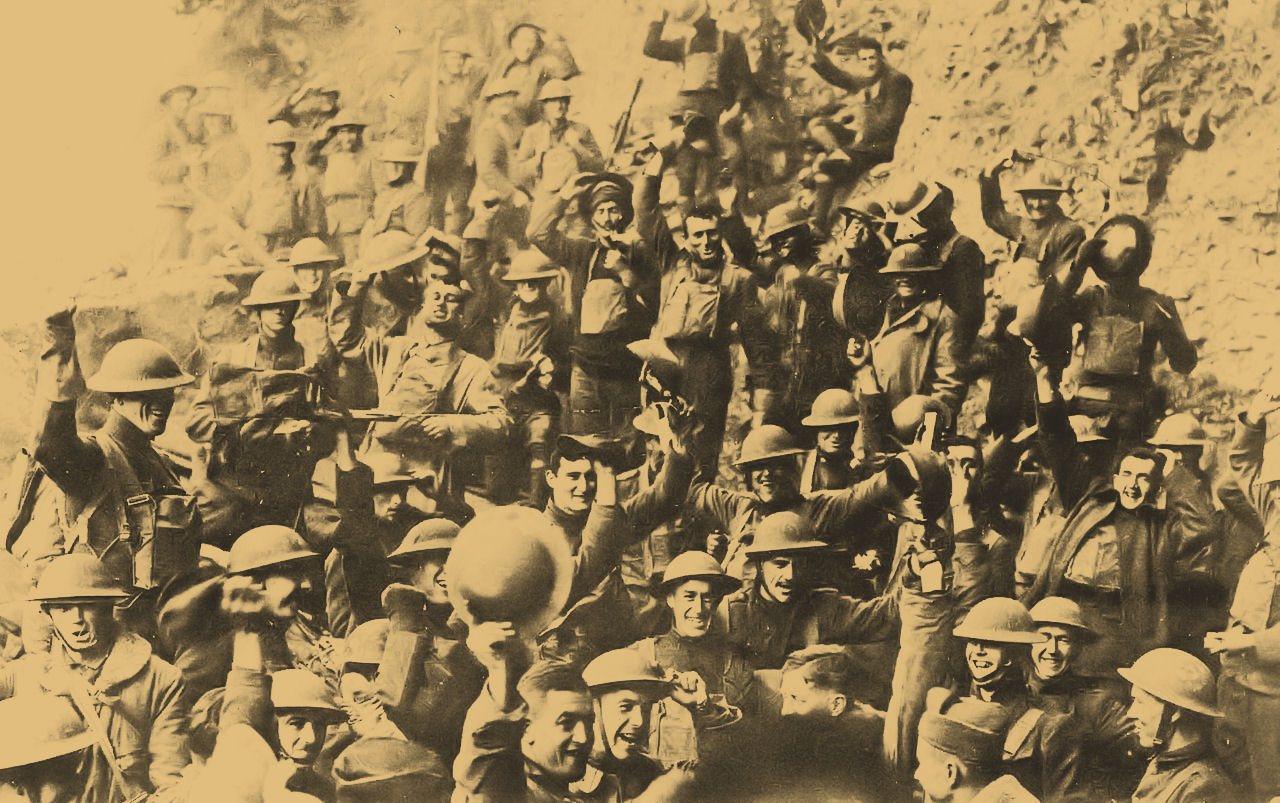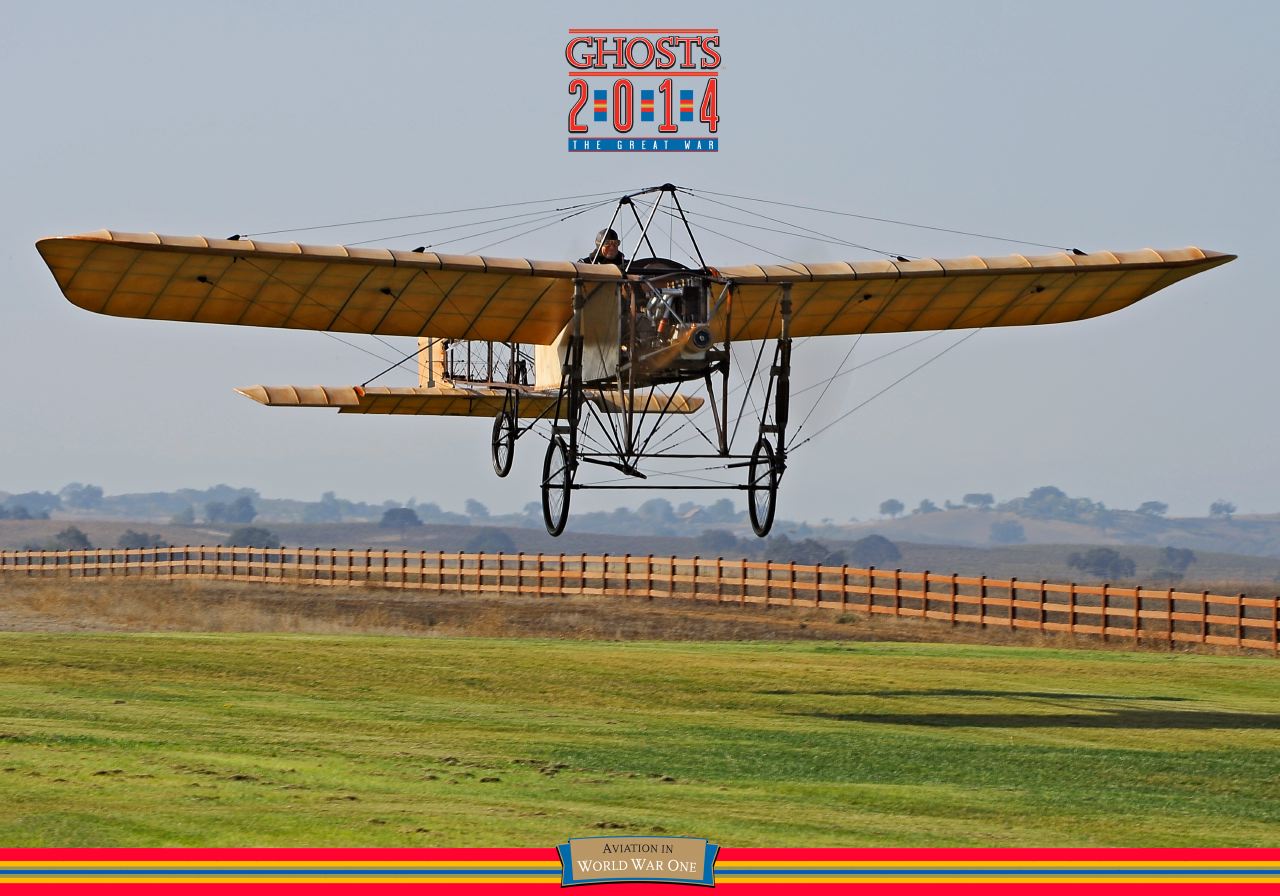
December 2013 |
 |
|


Let's Not Wait Until 2017 to Remember America's Participation
Recently, I was invited to pass on my views on how the United States could commemorate its role in the Great War. I'd like to share my thoughts on one issue that I included in my letter with readers of the Trip-Wire: "Please do not. . . wait until April 2017 to start commemorating America's participation in the war." The nation was not a combatant until then, but was most certainly influencing the events "over there" and, meanwhile, Americans were being affected by the war in many ways, both dramatic and subtle. America's history before entering the war is varied and most interesting, including the declaration of neutrality and its peculiar application, President Wilson's diplomacy, the sinking of the Lusitania, the preparedness movement, the migration of American blacks out of the south and the birth of the Civil Rights Movement, the 1916 political campaign, the events in Mexico, and the march to war with more U-boat sinkings, the many Americans serving in the war in both military and humanitarian untis, the Zimmerman Telegram, and so forth. The fascinating but mostly-forgotten story of America's involvement 1914-1917 needs to be told in parallel as the events on the battlefields of those years are remembered.
MH

|
2013
 New York State Military Museum, "Fiery Trial and Sacrifice - New York and the First World War," ongoing exhibit, Saratoga Springs, NY. Virtual Tour. New York State Military Museum, "Fiery Trial and Sacrifice - New York and the First World War," ongoing exhibit, Saratoga Springs, NY. Virtual Tour.
 The National World War I Museum in Kansas City, MO, has a current exhibit running on "The Road to War," running through April 2014. Website. The National World War I Museum in Kansas City, MO, has a current exhibit running on "The Road to War," running through April 2014. Website.
 The MacArthur Memorial and Museum in Norfolk, VA, has a current exhibit running on "The 42nd 'Rainbow' Division in World War One," running through September 2014. Website. The MacArthur Memorial and Museum in Norfolk, VA, has a current exhibit running on "The 42nd 'Rainbow' Division in World War One," running through September 2014. Website.
2014
 The U.S. Air Force National Museum at Wright-Patterson AFB, OH, and the League of WWI Aviation Historians (OvertheFront.com), are collaborating on what will be the first U.S.-based mega-event for the WWI centennial. The League is scheduling its 2014 Seminar to correspond with the WWI Dawn Patrol Fly-In at the Museum in Dayton, OH, 24-28 September 2014. Mark it down on your calendar. The U.S. Air Force National Museum at Wright-Patterson AFB, OH, and the League of WWI Aviation Historians (OvertheFront.com), are collaborating on what will be the first U.S.-based mega-event for the WWI centennial. The League is scheduling its 2014 Seminar to correspond with the WWI Dawn Patrol Fly-In at the Museum in Dayton, OH, 24-28 September 2014. Mark it down on your calendar.
"The Freezing Day"
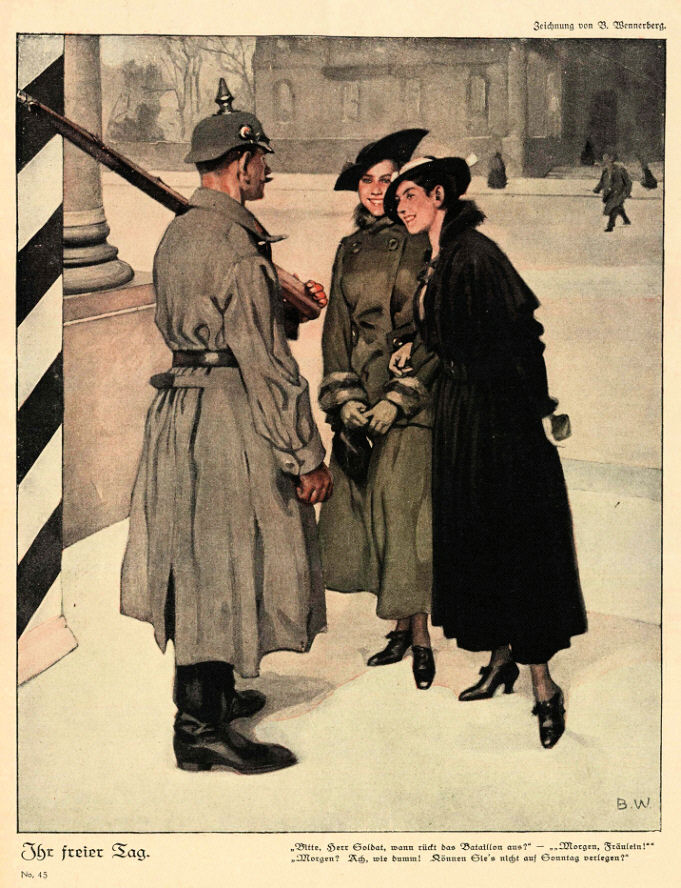
By Swedish Artist Brynolf (Bruno) Wennerberg, who lived in Munich during the war
(From Tony Langley's collection)

I am obliged to report that, at the present moment, the Russian Empire is run by lunatics.
French Ambassador Maurice Paleologue, 14 January 1917
|
|
Merry Christmas to All
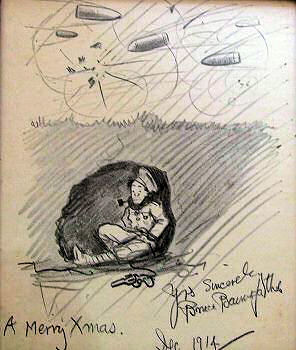
Our Friends Toni and Valmai Holt Are Making Sure That Bruce Bairnsfather Is Not Forgotten During the Centennial. Check In With Them at Their
Facebook Page

The Christmas Truce of 1914
This is a perennial favorite which we have touched upon many times in past Christmas seasons. This year, we have tried to search out some newer material on the legendary event.
 Overview of the Christmas Truce (Includes preceding events and list of participating units)
Overview of the Christmas Truce (Includes preceding events and list of participating units)
 Private Frederick Heath's Letter
Private Frederick Heath's Letter
 The Christmas Truce as an Expression of "Live and Let Live"
The Christmas Truce as an Expression of "Live and Let Live"
 About the Football Match
About the Football Match
 Photos of the Truce of the Imperial War Museum
Photos of the Truce of the Imperial War Museum
 German Soldiers Started It All
German Soldiers Started It All
 Reminiscences by the Participants and One Notable Non-Participant
Reminiscences by the Participants and One Notable Non-Participant
 Bairnsfather on the Christmas Truce (See also accompanying article on demystifying the Truce)
Bairnsfather on the Christmas Truce (See also accompanying article on demystifying the Truce)

The Infamous Reprisal Camp
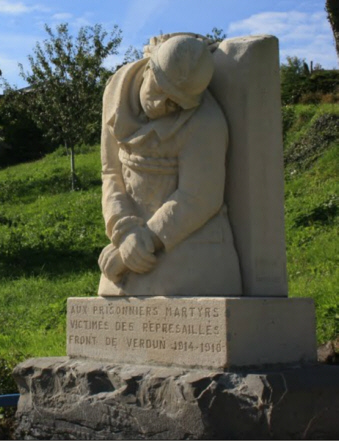
As the Battle of Verdun wound down in December 1916, the German Army demanded that the French withdraw the camps for their German prisoners to a distance of 30 km behind the front line. If the terms were not met the Germans threatened to place their French prisoners within reach of French fire.
The terms were not met, so a camp was opened at the village of Flabas, very close to the famous Bois des Caures (article below). Almost 500 prisoners were held in an enclosure of 1500 square meters. The prisoners were brutally treated. After several months the French authorities relented and the prisoners were moved away from the front. The episode was never forgotten, however, and the monument shown stands in Flabas today recalling the incident.
|

|

U.S. Centennial Organizations & Resources
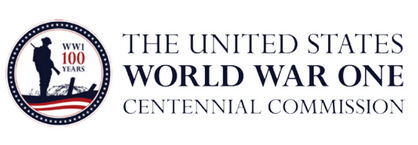
worldwar-1centennial.org/
|
A number of Centennial-related news items plus details on our reorganization to support the effort. I have decided to restructure my own magazine Over the Top as a "Centennial" publication—details below. MH
News Items:
 The National Centennial Commemorative Commission held its second meeting on 15 November in Washington, D.C. The previous evening the commission
hosted a social at the National Press Club which was well attended by both military and cultural attaches of many of the Centennial/Centenary international partners. At the meeting a brief tribute to
our late Chairman, Congressman Ike Skelton, was held. The Commission then formed sub-committees — Programs, Education, Fundraising, Audit— and facilitated a public comment period including a presentation by the Kimball War Memorial, the nation's first honoring the participation of African Americans in the war
(link). The National Centennial Commemorative Commission held its second meeting on 15 November in Washington, D.C. The previous evening the commission
hosted a social at the National Press Club which was well attended by both military and cultural attaches of many of the Centennial/Centenary international partners. At the meeting a brief tribute to
our late Chairman, Congressman Ike Skelton, was held. The Commission then formed sub-committees — Programs, Education, Fundraising, Audit— and facilitated a public comment period including a presentation by the Kimball War Memorial, the nation's first honoring the participation of African Americans in the war
(link).
 Michigan's WW1 Centennial Project has produced a wonderful video "The Hello Girls", which is now available on YouTube (link).
Michigan's WW1 Centennial Project has produced a wonderful video "The Hello Girls", which is now available on YouTube (link).
 Armistice/Veterans Day triggered some outstanding work from some of the national agencies that are working on commemorating the Centennial. Visit their sites listed below to feel proud:
Armistice/Veterans Day triggered some outstanding work from some of the national agencies that are working on commemorating the Centennial. Visit their sites listed below to feel proud:
Click on Image to Expand
The 64th Inf., 7th Division, AEF at the Hour of the Armistice
 Armistice Day, 1918: Situation Maps, Photos and Discussion from the U.S. Army Center of Military History
Armistice Day, 1918: Situation Maps, Photos and Discussion from the U.S. Army Center of Military History
 History of Veterans Day from the VA
History of Veterans Day from the VA
 The amazing story of Longshaw Kraus Porritt, who served with the Army, Navy and American Ambulance Field Service on the Western Front, Italian Front and aboard the USS Corsair in WWI, from the Veterans History Project, Library of Congress
The amazing story of Longshaw Kraus Porritt, who served with the Army, Navy and American Ambulance Field Service on the Western Front, Italian Front and aboard the USS Corsair in WWI, from the Veterans History Project, Library of Congress
Magazine of the World War I Centennial:
Coming in January 2014
Starting with our January Issue we are recasting our subscription magazine, Over the Top, as THE magazine of the World War I Centennial. With the first issue of our Volume 8, we will parallel month by month the Great War, initially covering the run up to the war and, then, with our June issue on the Black Hand and the Assassination of the Archduke, presenting cutting-edge articles on the critical earth-shaking events of that same month 100 years ago. Our 2014 Centennial editorial program is presented below with the link to download our flyer for ordering information. If you mention that you are subscribing through the Trip-Wire, you will also receive our December 2013 issue for free upon subscription or purchasing any of our past annual CD compilations.
Click on Image to Expand
Our December 2013 Issue and Our First As the Magazine of the World War I Centennial
1914 January 2014
The 99-Year Road to the Great War
|
1914 July 2014
The July Crisis Leads to War
|
1914 February 2014
Arrival of Wilhelm II & the Departure
of Bismarck; and Whither Russia,
Whence France |
1914 August 2014
Three Early Actions: the Ardennes,
Mons, Tannenberg |
1914 March 2014
The Prewar Game of Thrones
The European Alliance System |
1914 September 2014
The Battle of the Marne: the War's
Most Fateful Clash |
1914 April 2014
America's Improbable Route to
the Battlefields of Europe |
1914 October 2014
Turkey Enters the War; and the
Western Front in Full |
1914 May 2014
Revolutionaries, Anarchists &
Assassins |
1914 November 2014
Austria-Hungary Fails in Serbia;
and the Naval Blockade Begins |
1914 June 2014
The Black Hand & Sarajevo |
1914 December 2014
Battle of the Falklands; and the
Christmas Truce |
|

theworldwar.org/
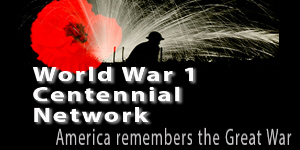
www.ww1-centennial.org/

history.army.mil/

www.firstdivisionmuseum.org/

www.abmc.gov/
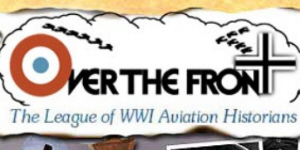
www.overthefront.com/

www.nationalmuseum.af.mil/

www.worldwar1.com/dbc/

wwi-inventory.org/

wisconsinhistory.org/

www.uswarmemorials.org/

www.macarthurmemorial.org/
|
|

December 1913
The Liman von Sanders Affair
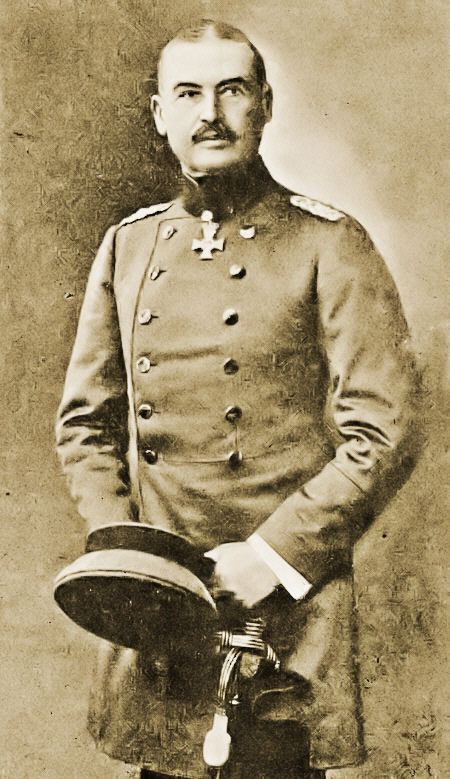
Liman von Sanders |
The last great diplomatic crisis before the Great War took place in late 1913 and early 1914. It exacerbated German-Russian tensions and also stressed the emerging Triple Entente of Russia, Great Britain, and France. At the center of the brouhaha was a German general named Liman von Sanders, whose name was later attached to this "Affair."
After their dismal performance in the recent wars in the Balkans and Libya, the "Young Turks" controlling the Ottoman Empire went shopping for military expertise and decided that Germany offered the best model for their army. The appointment of von Sanders to lead a mission for upgrading the Turkish army was announced in November 1913. His portfolio, however, went beyond advising and training. Part of his scope of duties was the command of a Turkish army corps in Constantinople. This triggered a ferocious response from the Russians, who: a) had their eyes on the Straits for access to the Mediterranean, and were secretly considering military options for seizing them, and b) did not want the Germans to be gaining a military foothold and political influence in the "Sick Man of Europe."
Russia decided to test its putative allies in Paris and London and asked them to join in energetic action against the German military mission. The British, though, found themselves somewhat embarrassed, since they had agreed to a similar role for the Turkish navy. Additionally, both France and Britain did not want to risk war. Both governments stipulated diplomatic support only.
Diplomacy at the
Highest Level
|
|
By January — with the Russians gritting their teeth — a deal was brokered where General von Sanders's direct command of the army corps was taken away from him by "kicking him upstairs" to the office of Inspector General of the Turkish Army.
Immediately afterwards, it seemed like the crisis had passed and that diplomatic methods had once again defused a potential war. Yet, the Kaiser and Tsar both believed they had — in their thinking — once again been forced to back down. Also, France was compelled to spend much of early 1914 reassuring the Russians that they would be stalwart allies in any future confrontations, culminating with President Poincare's fence-mending visit to Russian in the middle of the July crisis.
Sources: British Foreign Policy 1874-1914: The Role of India
By Sneh Mahajan
|
|

Flyers and application form for 2014 "Opening Moves" and
"Miracle of the Marne" Trips Now Available
(download pdf file here)

Click on Image to Send Email
|
|
|

|

Ray Kroc
(1902-1984)
Hamburger Entrepreneur
|
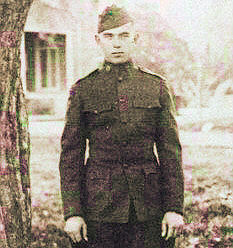
Ray Kroc, Would-Be
Ambulance Driver
| |
Ray Kroc's best known achievements are nicely summarized at Britannica Online:
[He was a] restaurateur and a pioneer of the fast-food industry. He was working as a blender salesman when he discovered a restaurant in San Bernardino, Calif., owned by Maurice and Richard McDonald, who used an assembly-line format to prepare and sell a large volume of hamburgers, French fries, and milk shakes. Beginning in 1955 Kroc opened his first McDonald's drive-in restaurant in Des Plaines, Ill., paying the brothers a percentage of the receipts. He soon began selling franchises for new restaurants, and he instituted a training program for owner-managers that emphasized automation and standardization. At the time of his death there were some 7,500 McDonald's restaurants worldwide; with more than 25,000 restaurants in the early 21st century, McDonald's was the world's largest food-service retailer.
He did have his World War I moment, however. Like fellow residents of Oak Park, Illinois, Ernest Hemingway, and Walt Disney, Kroc volunteered for Red Cross Service as an ambulance driver. The adventuresome young man lied about his age joining up at 15. He was still in training stateside, however, when the Armistice came, so he never quite made it "Over There."
Lillie Langtry
(1853-1929)
Beauty, Entertainer
Lillie Langtry, from the Isle of Jersey was a late-19th Century celebrity, who became notable at first in London Society for her great beauty and her liaison with Edward VII. The comedy, Lady Windermere's Fan, was written for her by Oscar Wilde. She later demonstrated additional talents, though. Lillie later succeeded as an actress on both sides of the Atlantic, as well as theatre management, winery operations in California, and raising race horses. She married a younger man, Hugo de Bathe, in 1899 and withdrew from the stage for a time to attend to her other interests.
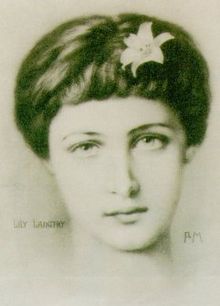
Lillie Langtry
|
She later returned to the stage and was touring in the U.S. when war was declared. Lillie, who had taken American citizenship, spent three wartime seasons in America. She returned to Great Britain in the summer, taking part in benefits for wounded. In 1917 she travelled home via Spain and France on a Spanish liner in hopes of avoiding the submarine threat and, after an adventuresome trip, ended up in London. At one point when asked what her husband was doing for the war effort, she famously replied, "My husband is a general's chauffeur somewhere in France."
Lillie played at the Coliseum for a while and was on stage there when a bomb exploded near the theatre. Her calm demeanor reassured the audience and she was credited for averting a panic. Soon after, she retired for the time, escaping to Regal Lodge, her country house at Kentford in horse racing country. Lillie spent the last year of the war cultivating vegetables with the help of the village girls to support the war effort. After the Armistice she retired to Monaco and succeeded in "Breaking the Bank at Monte Carlo" and writing a best-selling novel before passing away in 1929.
|
|

Support the Trip-Wire and our blog, Roads to the Great War, please. Yes, we do include ads for World War I-related products we support, besides selling subscriptions to our magazine Over the Top. This is how we keep our otherwise free publications rolling along. This month we are presenting information on a terrific Christmas present for your favorite military history or aviation enthusiast (or yourself).
The Editors Recommend
Ghosts of the Great War: 2014 Calendar
Phil Makanna is one of the world's greatest aviation photographers. He has been photographing historic aircraft since 1974. His work has been featured in numerous magazines such as Air and Space, Warbirds, Air Classics. and many others. He has also authored five GHOSTS books on historic military aircraft. Phil received the International Society of Aviation Photographers Lifetime Achievement Award in 2011. Each year Phil publishes calendars featuring his best work. Below is the cover of the 2014 GHOSTS calendar featuring classic World War I aircraft, followed by ordering information, and thumbnail images of each month's featured “GHOST”. By the way, on many of the daily entries, Phil includes notable anniversaries, birthdays and details about the air war of 1914-1918
Click on Image to Expand
Ghosts
2014
The Great War
$14.99 + s/h
For Ordering Online Go To:
http://www.ghosts.com/calendar14i.html
For Full Information on Phil's books, museum grade prints, and many other products,
go to his HOME PAGE at:
http://www.ghosts.com
Click on Image to Expand
|

Armistice — Remembrance — Veterans Day
November 2013
|
Images of how the Great War is still remembered.
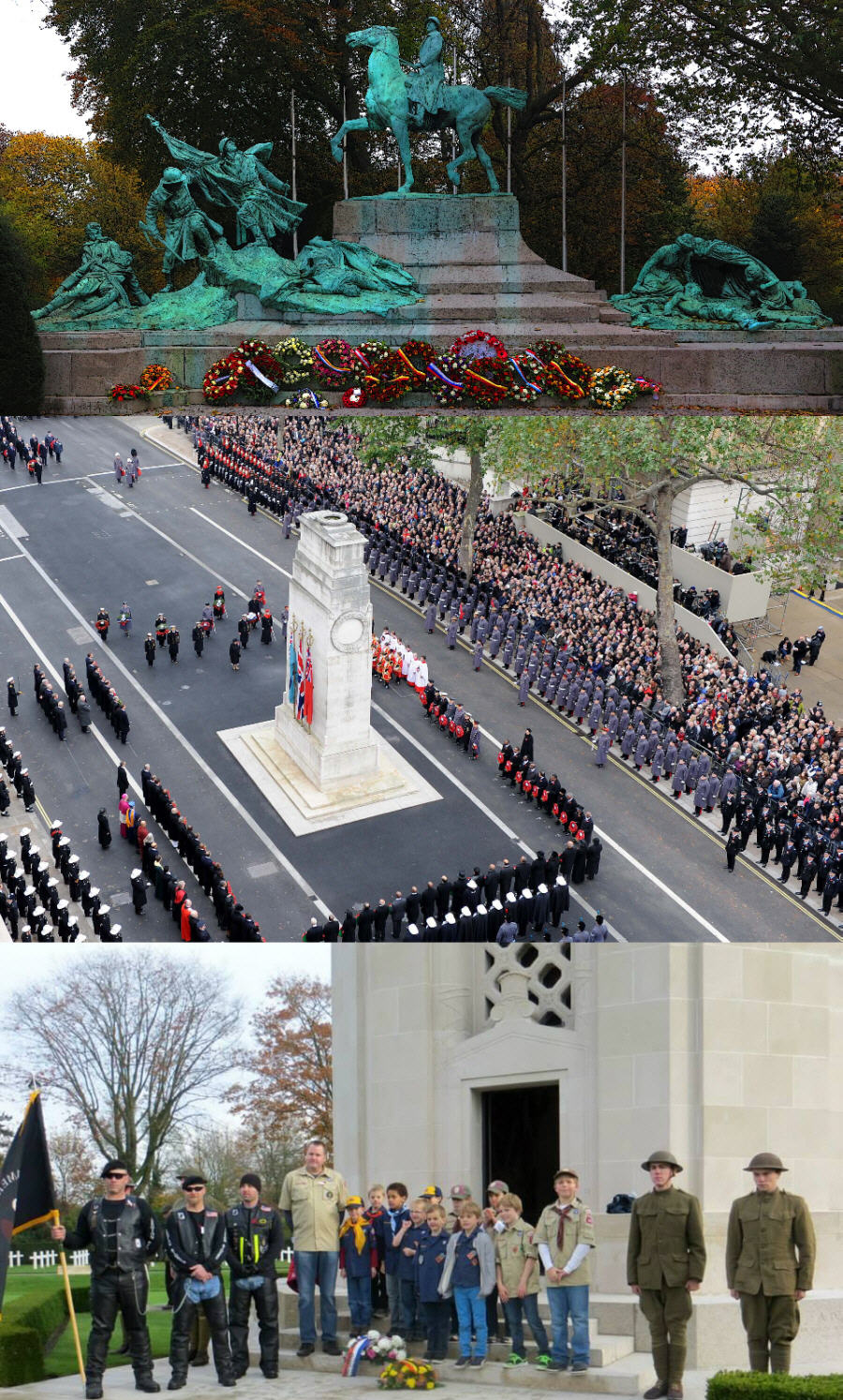
(Right Click "View Image" or "Open Image in New Tab" to View Full Size)
From the top: Wreathes Adorn the King Albert Memorial in Antwerp; in London, Queen Elizabeth Lays a Wreath at the Cenotaph; Attendees at the U.S. Flanders Fields Cemetery Include a Motorcycle Club, Boy Scouts, and Doughboy Reenactors. (A greatly enlarged version of the King Albert Memorial can be downloaded here.)
|
|
|

What Happened at Bois Caures?
When much of the German Army retreated north after the 1914 Battle of the Marne, Crown Prince Wilhelm's Fifth Army dug-in in a perimeter around Verdun. Facing them 14km northeast of Verdun were French soldiers in a wood named Bois des Caures. Both sides further fortified their positions for the better part of a year, when the Battle of Verdun would begin in their sector.
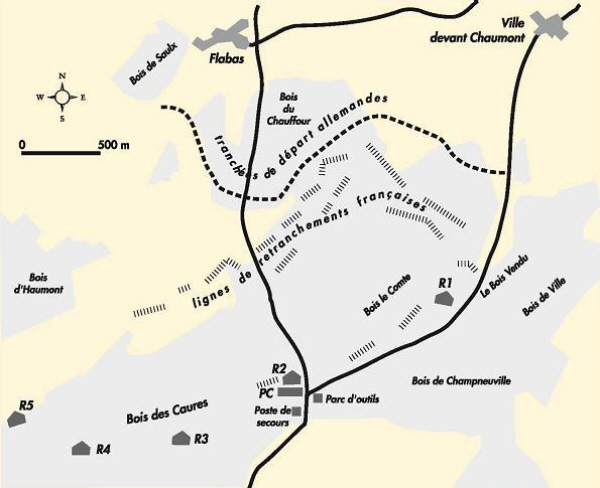
Frontline Trenches and French Redoubts (R1-5)
Taking command of the French defenses at Bois des Caures in 1915 was an industrious, formerly retired Lt. Colonel, who had returned to service when the war broke out, named Émile Driant. He had had parallel careers as a writer on nationalist matters and Futurism (often under the pen name Capitaine Danrit), which ended with the war, and as a Deputy for Nancy in Parliament, which did not. By July 1915 he had had already fought in six major engagements arourd Verdun. At Caures, Driant took command of two battalions of Chasseurs Alpin to defend 2000 meters of frontage. Recognizing the vulnerability of the position, he developed an in-depth system of defenses 800-1000 meters deep (see map above) with strengthened firing trenches and a series of five strongpoints surrounding a command post built with reinforced concrete. Meanwhile, he was already telling his parliamentary colleagues that "the [German] hammer will fall on the Verdun-Nancy line."
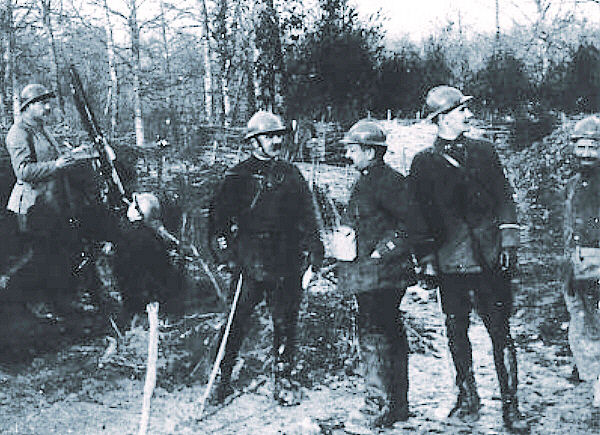
Driant (with cane) Inspecting the Position
From August 1915 on, Driant used his parliamentary connections to pass on warning of an impending German attack. This, of course, raised the ire of the army staff. In early 1916 his outposts began regularly reporting a build-up just behind the German front line. On 10 February 1916, he wrote his wife, telling her of a prisoner of war who had bragged that the Kaiser was planning to be strolling on the Verdun esplanade shortly. The attack Driant had long anticipated opened with a ten-hour barrage on 21 February followed by an infantry assault on Bois des Caures.
Driant's 1200 Chasseurs fought valiantly there in the face of overwhelming odds until, during the afternoon of the 22nd, he found he was outflanked on both sides. Driant ordered his few remaining men to withdraw toward the Fortress line. It was during that retreat that Driant himself was killed at the southern edge of the wood. Since the men with him had been taken prisoner by the Germans, firm news of his death did not reach Paris until 3 April. Some time after that Mme. Driant received a letter from Germany informing her that her husband had been honorably buried and that his grave would be carefully tended until peace returned.
In holding their positions and fighting to the end Col. Emile Driant and his Chasseurs, outflanked and overwhelmed, sacrificed their lives in order to slow the progress of the enemy. He is proudly remembered by the people of Verdun who still commemorate the fighting in the Bois des Caures with a ceremony held on 21 February every year.
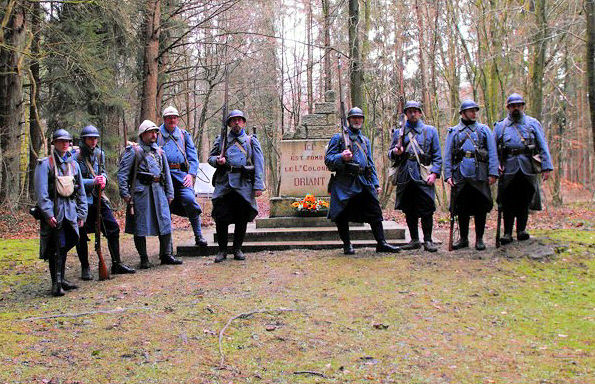
French Reenactors at the Site Where Driant Fell
|
|
|
Thanks to each and every one of you who has contributed material for this issue. Until 2014, your editor, Mike Hanlon. |
|
 (Or send it to a friend)
(Or send it to a friend)
|
Design by Shannon Niel
Content © Michael E. Hanlon
|
| |
|











